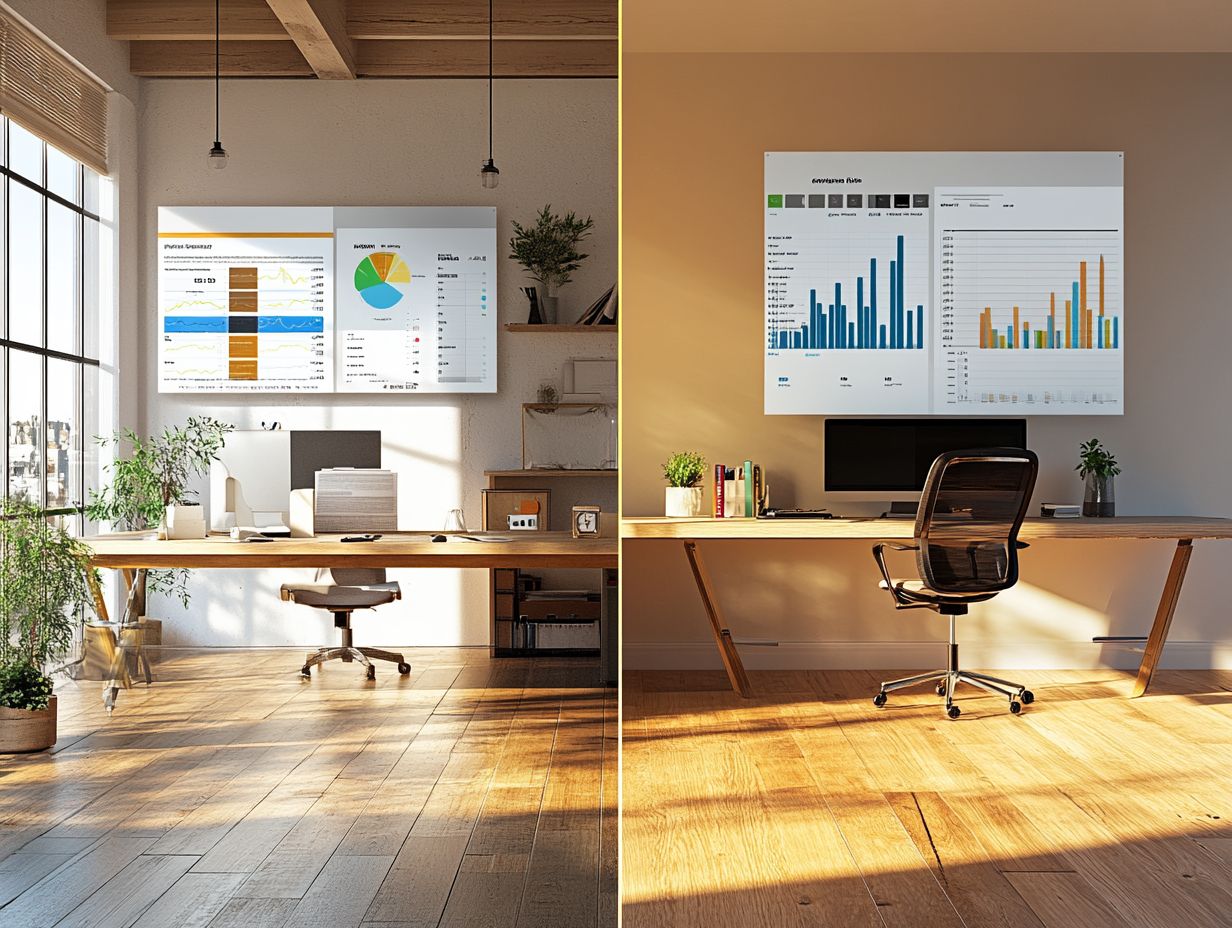Comparing Traditional vs. Digital Performance Management
In today s fast-paced business landscape, you ll find that performance management has shifted from traditional methods to embrace the latest digital innovations.
This article delves into the nuances of both approaches, exploring the tried-and-true practices of traditional performance management alongside the cutting-edge tools that are driving digital transformation.
You ll weigh the pros and cons, uncover key differences, and gain insights into selecting the best approach for your organization.
Whether you re aiming to refine existing systems or adopt new technologies, this guide will arm you with the essential knowledge needed for effective performance management.
Contents
- Key Takeaways:
- Traditional Performance Management
- Digital Performance Management
- Comparison of Traditional and Digital Approaches
- Choosing the Right Approach for Your Organization
- Frequently Asked Questions
- What is the difference between traditional and digital performance management?
- Which method is more effective for performance management: traditional or digital?
- Can traditional and digital performance management be used together?
- What are the benefits of using digital performance management?
- How does traditional performance management compare to digital performance management in terms of cost?
- Which method is better for providing feedback to employees: traditional or digital performance management?
Key Takeaways:

What is Performance Management?
Performance management is your systematic approach to enhancing employee effectiveness while propelling organizational success. It encompasses a variety of strategies that focus on assessing ways to measure how well employees are doing, aligning your individual goals with broader organizational objectives.
This process is crucial for helping employees grow and stay engaged, which in turn elevates workplace morale and boosts productivity.
By adopting a structured performance management approach, you create an environment that champions continuous improvement. This means setting clear expectations, leveraging performance metrics to gauge progress, and facilitating regular check-ins to discuss feedback and development opportunities.
You, as an HR professional, play a vital role in this journey. You design and implement performance appraisal systems, train managers to deliver effective feedback, and assist employees in identifying their career aspirations.
A well-executed performance management system not only enhances individual performance but also drives organizational success in today s competitive market.
Traditional Performance Management
In traditional performance management, you might find yourself navigating a landscape dominated by annual reviews and rigid performance evaluations. While these methods have played a significant role in the past, they often lead to feedback gaps that can impede your development.
Such an approach can stifle the continuous conversations that are essential in today s fast-paced work environment, failing to address the evolving needs of a modern workforce.
Methods and Practices
Traditional performance management methods often involve annual evaluations that rely heavily on predetermined metrics and subjective assessments. These practices can create feedback loops that stifle the development of a coaching culture.
To enhance the effectiveness of your performance evaluations, consider implementing more frequent check-ins and real-time feedback. This approach fosters continuous dialogue between managers and employees, making feedback an inherent part of the work routine rather than a once-a-year event.
By embracing these practices, you cultivate a culture that prioritizes ongoing development. Equipping leaders with training on how to provide constructive feedback gives the power to teams, transforming evaluations into collaborative opportunities for growth.
This shift clarifies expectations and energizes teams, encouraging employees to actively engage in their professional journeys, ultimately fostering a healthier and more engaged workplace.
Ready to revamp your performance management system? Let s dive in!
Pros and Cons

The pros and cons of traditional performance management reveal a dual narrative: structured performance evaluations can be effective, yet they also unveil significant shortcomings in employee satisfaction and workplace dynamics.
While these methods set clear expectations, they often lack the flexibility required in today s fast-paced organizational environment. Rigid frameworks can stifle creativity and hinder authentic conversations about development and growth.
This can lead to feelings of disengagement, making it easy to feel that your unique contributions are undervalued.
On the flip side, a structured approach can ensure that you and your teammates fully understand your goals and responsibilities, providing a clear roadmap to success.
While traditional methods have their benefits, they can also limit personal development and team collaboration. When organizations hold too tightly to outdated methods, they risk fostering a culture where feedback is infrequent and superficial.
Striking the right balance is essential for optimizing performance and fostering an environment where everyone can thrive.
Digital Performance Management
Digital performance management harnesses cutting-edge tools and cloud-based solutions to offer a more dynamic approach to employee evaluation.
By integrating continuous feedback and data that helps understand employee performance, you can develop a performance management system that aligns seamlessly with the evolving landscape of the modern workplace.
Technology and Tools
The evolution of performance management technology has ushered in a new era of digital tools, offering you real-time insights and enhancing feedback loops.
These tools are critical for a performance management system that promotes ongoing growth and deepens employee engagement.
Among these, platforms like 15Five and Lattice stand out for their intuitive interfaces and impressive functionalities.
With 15Five, you can effortlessly conduct weekly check-ins and gather employee feedback, ensuring that everyone remains aligned with your organizational goals.
Lattice emphasizes cultivating a culture of transparency by facilitating ongoing feedback and performance reviews, which helps in tracking progress.
This approach not only inspires but also motivates your team members.
By harnessing features such as goal tracking and analytics, you empower your organization to make informed decisions that ultimately enhance morale and productivity.
Benefits and Limitations
The benefits of digital performance management include enhanced employee engagement and robust performance analytics that yield actionable insights.
You ll need to tackle some exciting challenges, such as ensuring adequate training and effectively integrating technology into your existing processes.
To succeed, you must embrace this transition quickly, where your team becomes accustomed to receiving real-time feedback instead of relying solely on annual reviews.
While data-driven insights can empower your teams, it s essential that you interpret this data accurately to foster meaningful discussions about performance.
Without proper implementation, you risk creating an overwhelming influx of information, leading to confusion instead of clarity.
As you explore these new dynamics, you also face the challenge of maintaining a personal touch in evaluations, which is crucial for sustaining motivation and collaboration among team members.
Comparison of Traditional and Digital Approaches

The comparison between traditional and digital performance management approaches highlights notable distinctions in their core philosophies and operational methodologies.
Traditional methods typically rely on annual reviews, creating a more static evaluation process.
In contrast, digital performance management emphasizes continuous feedback and real-time performance metrics, fostering a dynamic environment that significantly enhances employee satisfaction and growth.
Discover the Key Differences and Similarities
The key differences between traditional methods and digital tools in performance management are striking, particularly regarding the frequency of evaluations and the nature of feedback. While traditional approaches often hinge on annual reviews, digital tools encourage ongoing conversations and continuous input.
This shift cultivates a more dynamic dialogue between you and your managers, allowing for real-time adjustments in performance expectations. In a traditional framework, feedback tends to be infrequent and often lacks specificity, which can lead to disengagement.
By embracing digital tools, organizations can hold regular check-ins and quick surveys that keep you engaged and informed. The types of feedback also differ significantly; with technology, feedback can be immediate and peer-driven, fostering a collaborative work environment. These strategies collectively enhance your satisfaction and contribute to the overall success of the organization.
Choosing the Right Approach for Your Organization
Selecting the ideal performance management approach for your organization demands a deep understanding of your unique needs and goals. As an HR professional, you hold an important role in assessing both traditional and digital methods.
Your task is to identify which adaptable strategies will seamlessly align with your organizational objectives while fostering employee development.
Considerations and Recommendations
When considering a performance management system, it s important to evaluate key factors like employee engagement, corporate culture, and alignment with your organizational objectives. As an HR professional, you play a vital role in providing insights that reflect these considerations to achieve optimal outcomes.
Create an environment that values employees; it enhances not only their performance but also their commitment to your organization. Fostering a culture of transparency and open communication builds trust, encouraging individuals to share their ideas and concerns without hesitation.
Focus on integrating feedback mechanisms that resonate with your strategic HR goals. This ensures that performance metrics not only measure productivity but also align with personal development and team collaboration. By addressing these elements, you can effectively drive cultural transformation and cultivate a high-performing workforce.
Frequently Asked Questions

What is the difference between traditional and digital performance management?
Traditional performance management is a manual process that involves paper-based performance evaluations and face-to-face meetings, while digital performance management relies on technology and tools to track and manage employee performance.
Which method is more effective for performance management: traditional or digital?
It depends on the specific needs and goals of the organization. Traditional performance management allows for more in-depth and personal evaluations, while digital performance management offers real-time data and analytics for more objective assessments.
Can traditional and digital performance management be used together?
Yes, organizations can combine elements of both traditional and digital performance management to create a hybrid approach that best suits their needs. This could involve using technology for data tracking and analysis while still incorporating face-to-face meetings for more personalized evaluations.
What are the benefits of using digital performance management?
Digital performance management offers several benefits, including increased efficiency, real-time data and analytics, and the ability to track progress and identify areas for improvement more easily.
How does traditional performance management compare to digital performance management in terms of cost?
Traditional performance management can be more costly due to the use of paper, printing, and in-person meetings. Digital performance management, on the other hand, can be more cost-effective as it eliminates the need for physical materials and can be accessed remotely.
Which method is better for providing feedback to employees: traditional or digital performance management?
Both traditional and digital performance management can effectively provide feedback to employees. Traditional performance management usually involves face-to-face reviews, offering detailed, personal feedback.
In contrast, digital performance management uses software tools for instant feedback. These methods allow you to track progress over time and keep the team engaged!




